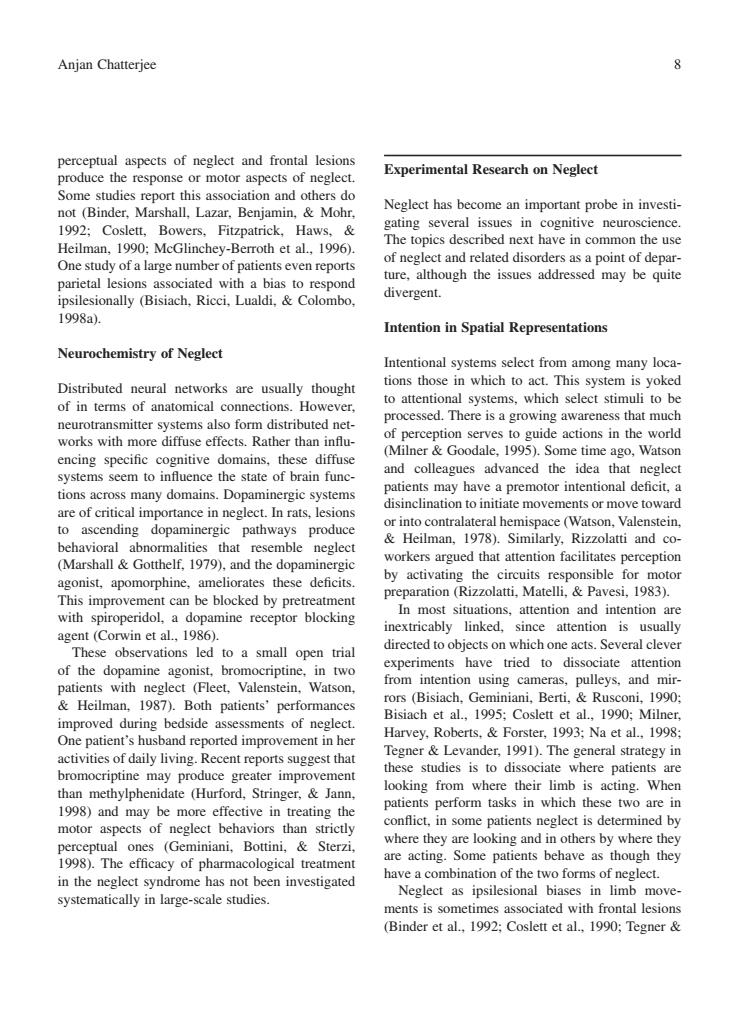正在加载图片...

Anian chatteriee 8 per onse or spects of neglect Experimental Research on Neglect studies and othe not (Binder.Marshall.Lazar.Beniamin.Mohr Neglect has become an important probe in investi 1992.Coslett atrick.Ha sever nce Heilman,1990:McGlinchey-B rroth et al. 1996 ics de scribed ne the One of a large no re depa ught e is divergent. 1998a Intention in Spatial Representation Neurochemistry of Neglect select from among many tions the works with more diffuse effects.Rather than influ of perception serves to guide actions in the world encing specific cognitive domains,these diffuse (Milner Goodale,1995).Some time ago,Watson systems seem to influence the state of brain fund and colleagues advanced the idea that neglect patients may have a premotor intentional deficit,a tions across many domains.Dopaminergic systems are of critical importance in neglect.In rats,lesions disinclination to initiate movements or move toward to ascending dopaminergic pathways produce or into contralateral hemispace (Watson,Valenstein, Heilman.1978).Similarly.Rizzolatti and co behavioral abnormalities that resemble neglect (Marshall Gotthelf,1979).and the dopaminergic workers argued that attention facilitates perception by activating the circuits responsible for motor agonist,apomorphine,ameliorates these deficits preparation (Rizzolatti.Matelli.Pavesi.1983). This improvement can be blocked by pretreatment with spiroperidol,a dopamine receptor blocking In most situations.attention and intention are inextricably linked. since attention is usually agent(Corwin et al.,1986). These observations led to a small open trial directed to objects on which one acts.Several clever of the dopamine agonist,bromocriptine.in two experiments have tried to dissociate attention from intention using cameras pulleys and mir patients with neglect (Fleet Valenstein.Watson Heilman 1987)Both patients'performances rors (Bisiach.Geminiani,Berti.Rusconi.1990: Bisiach et al 1995:Coslett et al 1990:Milner improved during bedside assessments of neglect. One patient's husband reported improvement in her Harvey.Roberts.Forster.1993:Na et al..1998 activities of daily living Recent reports suggest that Tegner&Levander,1991).The general strategy in thes bromocriptine may produce greater impr studies is to dissociate where patients vement than methylphenidate (Hurford.Stringer.Jann looking from where their limb is acting.Wher 1998)and may be more effective in treating the patients perform tasks in which these two are in motor aspects of neglect behaviors than strictly conflict,in some patients neglect is determined by ceptual ones (Geminiani,Bottini.Sterzi wher Some n andn others by where the 1998).The efficacy of pharmacological treatment nts behave as though they mhinatio in the neglect syndr has not bee n of the two fo s of neglect. scale studies nal biase in limb m ciated with fr tal les (Binder r et 199 lett et al.,1990:Tegner& perceptual aspects of neglect and frontal lesions produce the response or motor aspects of neglect. Some studies report this association and others do not (Binder, Marshall, Lazar, Benjamin, & Mohr, 1992; Coslett, Bowers, Fitzpatrick, Haws, & Heilman, 1990; McGlinchey-Berroth et al., 1996). One study of a large number of patients even reports parietal lesions associated with a bias to respond ipsilesionally (Bisiach, Ricci, Lualdi, & Colombo, 1998a). Neurochemistry of Neglect Distributed neural networks are usually thought of in terms of anatomical connections. However, neurotransmitter systems also form distributed networks with more diffuse effects. Rather than influencing specific cognitive domains, these diffuse systems seem to influence the state of brain functions across many domains. Dopaminergic systems are of critical importance in neglect. In rats, lesions to ascending dopaminergic pathways produce behavioral abnormalities that resemble neglect (Marshall & Gotthelf, 1979), and the dopaminergic agonist, apomorphine, ameliorates these deficits. This improvement can be blocked by pretreatment with spiroperidol, a dopamine receptor blocking agent (Corwin et al., 1986). These observations led to a small open trial of the dopamine agonist, bromocriptine, in two patients with neglect (Fleet, Valenstein, Watson, & Heilman, 1987). Both patients’ performances improved during bedside assessments of neglect. One patient’s husband reported improvement in her activities of daily living. Recent reports suggest that bromocriptine may produce greater improvement than methylphenidate (Hurford, Stringer, & Jann, 1998) and may be more effective in treating the motor aspects of neglect behaviors than strictly perceptual ones (Geminiani, Bottini, & Sterzi, 1998). The efficacy of pharmacological treatment in the neglect syndrome has not been investigated systematically in large-scale studies. Experimental Research on Neglect Neglect has become an important probe in investigating several issues in cognitive neuroscience. The topics described next have in common the use of neglect and related disorders as a point of departure, although the issues addressed may be quite divergent. Intention in Spatial Representations Intentional systems select from among many locations those in which to act. This system is yoked to attentional systems, which select stimuli to be processed. There is a growing awareness that much of perception serves to guide actions in the world (Milner & Goodale, 1995). Some time ago, Watson and colleagues advanced the idea that neglect patients may have a premotor intentional deficit, a disinclination to initiate movements or move toward or into contralateral hemispace (Watson, Valenstein, & Heilman, 1978). Similarly, Rizzolatti and coworkers argued that attention facilitates perception by activating the circuits responsible for motor preparation (Rizzolatti, Matelli, & Pavesi, 1983). In most situations, attention and intention are inextricably linked, since attention is usually directed to objects on which one acts. Several clever experiments have tried to dissociate attention from intention using cameras, pulleys, and mirrors (Bisiach, Geminiani, Berti, & Rusconi, 1990; Bisiach et al., 1995; Coslett et al., 1990; Milner, Harvey, Roberts, & Forster, 1993; Na et al., 1998; Tegner & Levander, 1991). The general strategy in these studies is to dissociate where patients are looking from where their limb is acting. When patients perform tasks in which these two are in conflict, in some patients neglect is determined by where they are looking and in others by where they are acting. Some patients behave as though they have a combination of the two forms of neglect. Neglect as ipsilesional biases in limb movements is sometimes associated with frontal lesions (Binder et al., 1992; Coslett et al., 1990; Tegner & Anjan Chatterjee 8